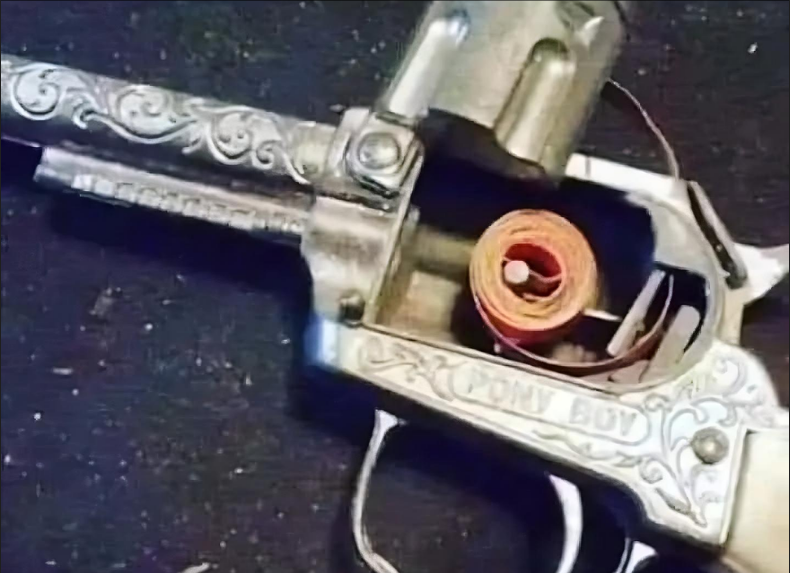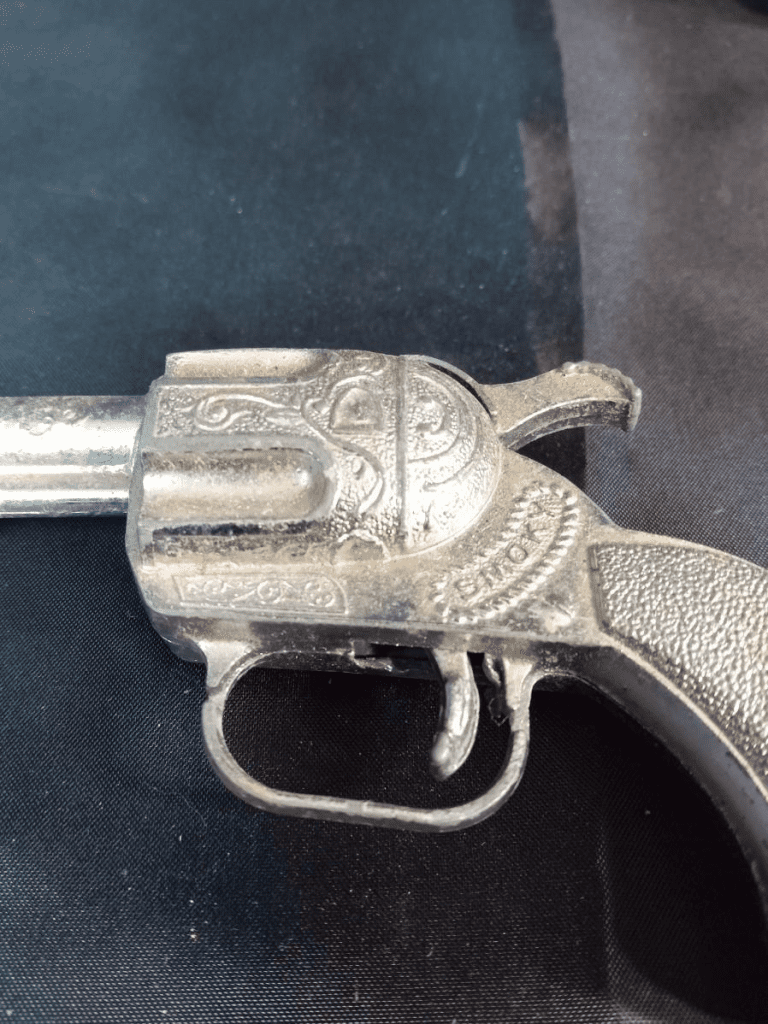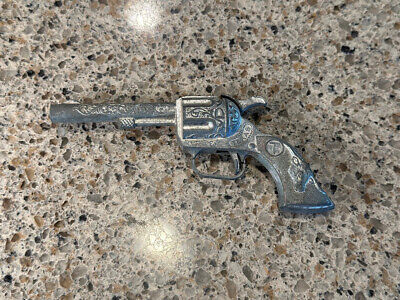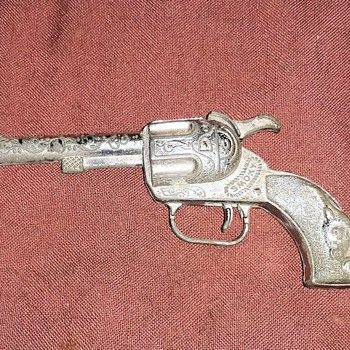Cap guns have been a beloved childhood toy for generations, sparking imaginations and allowing kids to mimic their favorite cowboys, soldiers, and detectives. These small, yet mighty, toy guns create a realistic bang and puff of smoke when a percussion cap ignites, simulating the sound of a real gunshot. From their humble beginnings in cast iron to their modern-day plastic counterparts, cap guns have a rich history that ties into both real-world firearms development and pop culture.
What Exactly Is a Cap Gun?

A cap gun, also known as a cap pistol or cap rifle, is a toy gun designed to produce a loud sound similar to a gunshot. It does this by igniting a small percussion cap, which contains a shock-sensitive explosive compound. When the gun’s hammer strikes the cap, it creates a distinctive click, along with a small burst of smoke. This action mimics the function of older firearms that also used caps, though the toy versions are, of course, much safer and designed for play.
Cap guns are made from various materials. In earlier times, they were primarily constructed from cast iron, but after World War II, manufacturers shifted to lighter zinc alloys. Today, most cap guns are made from plastic, which is cheaper and more durable for kids’ use.
The Mechanics Behind the Bang: How Cap Guns Work
The secret to a cap gun’s sound lies in the small discs or strips of explosive material used inside the gun. These caps are typically made from Armstrong’s mixture, a compound that creates a small explosion when struck. The caps are about 1.4 to 1.6 millimeters in diameter and come in various forms, including rolls, discs, or rings.
Here’s how it works:
- The cap is loaded into the gun, usually in a revolving cylinder or a strip that advances with each pull of the trigger.
- When the trigger is pulled, the hammer strikes the cap, causing it to ignite and make a popping sound, along with a tiny puff of smoke.
- In some models, the mechanism even mimics the action of a real gun, rotating the cylinder and advancing the next cap into position.
This simple yet effective mechanism creates an immersive experience for kids (and nostalgic adults), as it mimics the feel and sound of firing a real gun—without the danger.
The Golden Age of Cap Guns: A Toy Empire Built on Western Heroes
The popularity of cap guns exploded in the post-World War II era, especially during the 1950s and 1960s when Western television shows and movies were at their peak. Children idolized cowboy stars like Roy Rogers, Gene Autry, and The Lone Ranger, who often sported cap guns modeled after real-life weapons from the Old West. Manufacturers capitalized on this craze, producing millions of cap guns inspired by these larger-than-life characters.
Companies like Mattel, Hubley, and Nichols Industries dominated the market during this “Golden Age” of cap guns. Their models ranged from small derringers to larger, more elaborate rifles. Many of these cap guns bore names inspired by their Western roots, such as the “Stallion 45,” “Mustang,” and “Texan.”
Cap guns during this time weren’t just toys—they were cultural icons. Kids would role-play epic battles between cowboys and outlaws, mimicking the thrilling adventures they saw on TV. These toys helped define a generation’s playtime and remain nostalgic symbols for many adults today.
The Evolution of Cap Guns: From Western Heroes to Military Themes

As the Western craze began to fade, so did the demand for cowboy-themed cap guns. However, manufacturers didn’t let the trend die. Instead, they evolved the toy to fit other popular genres, such as military and secret agent themes. Toy companies began producing cap guns modeled after modern firearms, including semi-automatic pistols and submachine guns.
Mattel, in particular, made waves with its automatic-firing cap gun that was modeled after the iconic Thompson submachine gun. This toy was part of a tie-in with popular franchises like Dick Tracy, Planet of the Apes, and Green Beret Guerilla Fighter.
While cap guns are no longer the dominant toy they once were, their ability to adapt to changing cultural trends has helped them remain a beloved toy for decades.
Safety and Legal Changes: The Impact of Realism on Toy Guns
While cap guns were once designed to look nearly identical to real firearms, this realism came with its own set of dangers. In the 1980s, several incidents occurred in which law enforcement officers mistakenly thought children’s cap guns were real firearms, leading to tragic accidents.

In response to these incidents, the U.S. passed laws in 1988 requiring all toy guns to have a bright orange or red tip on the barrel, or to be manufactured in bright, unrealistic colors. This change ensured that cap guns could no longer be mistaken for actual firearms, making playtime safer for children and reducing the risk of dangerous misunderstandings.
Types of Cap Guns and Caps: From Rolls to Rings
Cap guns come in many shapes and sizes, as do the types of caps they use. Here’s a breakdown of the most common types:
- Roll Caps: These are strips of paper, usually containing 50 to 500 caps per roll. They are loaded into the gun and advanced with each trigger pull.
- Ring Caps: These are circular plastic rings, often with eight or twelve caps arranged in a circle. They are designed for revolver-style cap guns.
- Strip Caps: Similar to roll caps, strip caps are longer pieces of plastic with individual caps placed along the strip.
- Single Caps: Some cap guns use individual caps that are loaded into a bullet-like chamber, offering a more realistic experience when firing.
Cap guns themselves also vary, from small derringers to larger rifles. Some cap guns mimic semi-automatic firearms, while others model their designs after revolvers or other classic guns.
The Legacy of Cap Guns: A Nostalgic Symbol of Childhood

Though their popularity has waned, cap guns remain a nostalgic symbol for many adults who grew up in the mid-20th century. These toys were not just playthings—they represented a time of imagination, where children could become cowboys, soldiers, or detectives, fighting imaginary battles in their backyards.
Today, collectors seek out vintage cap guns, many of which have become prized pieces of Americana. The cultural significance of these toys, combined with their historical ties to real firearms, makes cap guns a fascinating relic of a bygone era.
Conclusion: The Enduring Charm of Cap Guns
Cap guns may have started as toys, but they’ve evolved into much more—a cultural phenomenon, a collector’s item, and a symbol of childhood adventures. Whether inspired by Western heroes or military action, these toys have left an indelible mark on generations of kids who grew up playing with them.
While the toy industry has moved on to more advanced forms of entertainment, the simple joy of firing a cap gun remains timeless. Its ability to mimic real-life action, while staying safe for kids, makes the cap gun a truly unique and enduring toy in the history of play.


